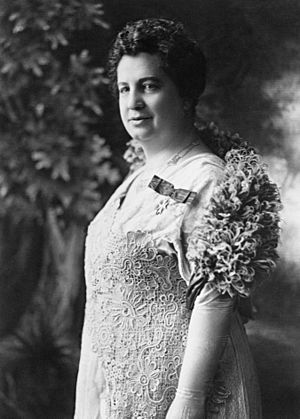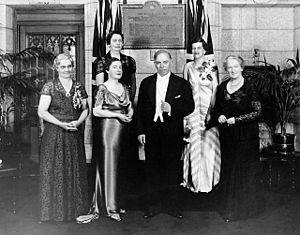Emily Murphy facts for kids
Quick facts for kids
Emily Murphy
|
|
|---|---|
 |
|
| Born |
Emily Gowan Ferguson
14 March 1868 Cookstown, Ontario, Canada
|
| Died | 27 October 1933 (aged 65) Edmonton, Alberta, Canada
|
| Occupation | Magistrate, activist, author |
| Known for | Women's rights activist |
| Spouse(s) |
Arthur Murphy
(m. 1887) |
| Children | 4 |
Emily Murphy (born Emily Gowan Ferguson; 14 March 1868 – 27 October 1933) was a Canadian women's rights activist and author. An activist is someone who works to bring about social or political change. In 1916, she became the first female magistrate in Canada and across the British Empire. A magistrate is a type of judge who handles less serious cases.
Emily Murphy is famous for her work in Canadian feminism. She helped answer the important question of whether women were considered "persons" under Canadian law. She is known as one of "The Famous Five" (also called "The Valiant Five"). This group of Canadian women's rights activists also included Henrietta Muir Edwards, Nellie McClung, Louise McKinney, and Irene Parlby.
In 1927, these women started the "Persons Case." They argued that women should be seen as "qualified persons" who could serve in the Senate. The Senate is a part of Canada's Parliament. At first, the Supreme Court of Canada said women were not "persons." But the women appealed to the Judicial Committee of the Privy Council in Britain, which was Canada's highest court at the time. The women won their case, changing Canadian law forever.
Contents
Early Life and Family
Emily Murphy was born in Cookstown, Ontario, on March 14, 1868. She was the third child of Isaac Ferguson and Emily Gowan. Her father was a successful businessman. Emily often joined her two older brothers in their adventures. Her father encouraged all his children, boys and girls, to share responsibilities equally.
Emily grew up influenced by her family. Her maternal grandfather, Ogle Robert Gowan, was a politician. Two of her uncles were important figures: one was a Supreme Court justice, and the other was a senator. Her brother also became a lawyer and a Supreme Court member.
Emily's parents supported her getting a good education. She went to Bishop Strachan School, a private Anglican school for girls in Toronto. There, she met her future husband, Arthur Murphy, who was 11 years older than her.
In 1887, Emily and Arthur married. They had four daughters: Madeleine, Evelyn, Doris, and Kathleen. Sadly, Doris died. After this loss, the family moved west. They went to Swan River, Manitoba, in 1903, and then to Edmonton, Alberta, in 1907.
Emily Murphy's Career and Activism
Fighting for Women's Property Rights

While her husband Arthur worked as a priest, Emily learned about the poverty around her. When her children grew up and became independent, Emily, at age 40, started organizing women's groups. These groups helped isolated housewives meet, share ideas, and plan projects together. Emily also began speaking out about the poor living conditions in society.
She became very interested in protecting women and children's rights. This happened after she heard about an unfair situation. An Albertan woman's husband sold their family farm and then left his wife and children with no home or money. At that time, property laws did not protect the wife. She had no legal recourse, meaning no way to get justice through the law.
This case inspired Emily Murphy to start a campaign. She wanted to make sure married women had rights to their property. With support from many women, she pushed the Alberta government to change the laws. In 1916, Emily successfully convinced the Alberta legislature to pass the Dower Act. This law gave a woman legal rights to one-third of her husband's property. This first political victory made Emily Murphy known as a strong women's rights activist.
Becoming Canada's First Female Magistrate

Emily Murphy's success with the Dower Act and her work with women's groups led her to ask for a female magistrate. She wanted a woman judge for women's courts.
In 1916, Emily and a group of women tried to watch a trial involving women. They were told to leave the courtroom because the evidence was "not fit for mixed company." Emily found this unacceptable. She protested to the provincial Attorney General. She argued, "If the evidence is not fit company, then the government must set up a special court presided over by women, to try other women."
Her request was approved! On July 1, 1916, Emily Murphy became the first woman police magistrate in the British Empire.
However, her appointment as a judge led to a big challenge. In her first case, the prisoner's lawyer questioned her right to make a decision. He argued that she was not legally a "person." The Provincial Supreme Court disagreed and denied the appeal. This challenge highlighted a major legal problem for women.
The Famous Persons Case
In 1917, Emily Murphy began a new fight. She wanted women to be officially declared "persons" in Canada. If they were "persons," they could then serve in the Senate. At this time, women in English Canada had gained (or were about to gain) the right to vote. But they still faced a legal barrier to becoming senators.
An Edmonton lawyer, Eardley Jackson, challenged Emily's role as a judge. He argued that women were not considered "persons" under the British North America Act 1867. This idea came from an old British law from 1876. It said that "women were eligible for pains and penalties, but not rights and privileges." His appeal was quickly rejected.
In 1919, Emily Murphy led the first conference of the Federated Women's Institutes of Canada. This group passed a resolution asking for a woman senator to be appointed. The National Council of Women and the Montreal Women's Club also supported this idea. They chose Emily Murphy as their preferred candidate.
Emily started planning how to get a clear answer about women's status in the BNA Act. She wanted to know how women could become senators. She asked four other Albertan women for help. On August 27, 1927, Emily and human rights activist Nellie McClung, former politician Louise McKinney, women's rights campaigner Henrietta Edwards, and Alberta cabinet minister Irene Parlby signed a petition. They asked the federal Cabinet to send the issue to the Supreme Court of Canada.
The women asked two questions in their petition. But the government changed it to one question for the Supreme Court: "Does the word 'person' in Section 24 of the British North America Act include female persons?"
This campaign became known as The Persons Case. It reached the Supreme Court of Canada in March 1928. The Court decided that women were not qualified to sit in the Senate. So, the five women appealed to the Judicial Committee of the Privy Council in Britain.
On October 18, 1929, the Privy Council made a historic decision. In a ruling called Edwards v. Canada (Attorney General), they declared that the word 'persons' in Section 24 of the BNA Act of 1867 should include both males and females. This meant women were now eligible to serve in the Senate!
Even with this important ruling, Emily Murphy never served in the Senate. The first Senate seat that opened after the ruling was in Quebec, but Emily lived in Alberta. Also, the Prime Minister at the time, William Lyon Mackenzie King, was a Liberal. Emily Murphy was a Conservative. So, another woman, Cairine Wilson, became the first female senator in 1930.
When the Conservatives won the 1930 federal election, Emily Murphy was again considered for the Senate in 1931. But she was passed over because the open seat was for a Catholic senator, and Emily was Protestant. Emily Murphy died in 1933, never fulfilling her dream of sitting in Canada's upper chamber.
The five women who brought the Persons Case were known as the Famous Five (or the Valiant Five). They were leaders in social reform and women's rights. They challenged old ideas and set an important example in Canadian history. In Canada's Senate Chamber, a plaque honors these five women. It says they helped women be recognized as persons who could be appointed to the Senate. Emily Murphy and the rest of the Famous Five were also featured on the back of the Canadian 50-dollar bill issued in 2004.
In October 2009, the Senate voted to name Emily Murphy and the rest of the Famous Five Canada's first "honorary senators."
Emily Murphy's Views
Thoughts on Social Issues
In the early 1900s, many people believed that science could solve social problems. Emily Murphy was one of them. She thought that some problems in society came from mental differences.
Emily was a pacifist, meaning she believed in peace and was against war. She thought that wars happened because countries needed more land for their growing populations. She believed that if populations were controlled, there would be less need for land, and wars might stop.
Her solution to these social issues was eugenics. This was a belief that society could be improved by controlling who reproduced. She thought that people with mental or social challenges had more children than "human thoroughbreds," which meant people she considered more capable. She wrote that children with mental differences were "a menace to society and an enormous cost to the state." She believed that science showed these conditions could be passed down through families. She even wrote to a government minister, saying it was "a neglect amounting to a crime" to let certain women keep having children.
Legacy and Recognition
Emily Murphy's legacy is sometimes debated. Her important work for feminism is weighed against her views on race and her support for eugenics.
When the Famous Five are remembered, like on the fifty-dollar bill, people often re-examine Emily Murphy's legacy. Her supporters point out that she lived at a time when racist views were common, not unusual. They argue that her views were actually more forward-thinking than many people around her.
Emily Murphy's house in Edmonton, Alberta, is now a recognized historic place in Canada. She lived there from 1919 until her death in 1933. Today, it is on the University of Alberta campus and houses Student Legal Services.
In 1958, the Canadian government recognized her as a Person of National Historic Significance. A plaque honoring her is at Emily Murphy Park in Edmonton. The "National Persons" case was also recognized as a National Historic Event in 1997, with another plaque at the same park.
See also
 In Spanish: Emily Murphy para niños
In Spanish: Emily Murphy para niños

